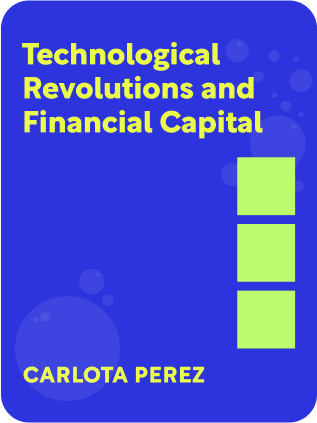

This article is an excerpt from the Shortform book guide to "Technological Revolutions and Financial Capital" by Carlota Perez. Shortform has the world's best summaries and analyses of books you should be reading.
Like this article? Sign up for a free trial here .
What is financial innovation? In which phase of technological revolution does financial innovation happen and how does it work?
Financial innovation occurs when a technological revolution reaches maturity and then can explore wealth-building endeavors related to the revolution’s economic prosperity.
Read more about financial innovation and phase 4 below.
Phase 4: Maturity and Financial Innovation
Finally, the technological revolution begins to deplete its possibilities. Refer to Phase 0 above. This is the twilight of the golden age, “though it shines with false splendor.”
Core industries experience market saturation and decreasing returns.
- To increase market share, the dominant firms concentrate through mergers and acquisitions, turning into oligopolies.
- Activities are migrated to less-saturated markets abroad, redeploying the prevailing paradigm. However, this exhausts relatively quickly because the knowledge gained in earlier phases accelerates the deployment in new markets.
Widespread market and production experience shorten the life cycles of later products because of very rapid learning and saturation curves.
Those who reaped the benefits of the golden age continue to believe in the virtues of the system. They insist on continuous progress of the current paradigm, in a complacent blindness.
But promises of constant progress and social progress are not met, leading to labor and political unrest. The young and nonconformists stage rebellions and romantic protests.
Firms amass money without profitable investment outlets, creating idle capital.
Financial capital begins separating from production capital again, seeking more profitable or exciting things and leading to innovation in finance.
- It supports investment in marginalized sectors and the periphery of the revolution.
- Bad loans are granted to weaker creditors, particularly internationally.
- Unorthodox practices like tax avoidance reign.
Radical innovation in finance are demanded to propel further growth. During the Synergy phase, innovations that disrupted the diffusing paradigm were rejected. Now, they are sought after by firms desperate for growth.
Phases of Financial Innovation
Throughout the revolution, innovations in financial capital enable the diffusion of technology.
Carlota Perez classifies financial innovations along six types, then illustrates when innovations in each type occur.
| Type | Purpose | Examples |
| A | Invest in new products or services | Venture capital for radical innovationsJoint stocks for large investments |
| B | Help growth or expansion | Production expansion domestically and abroad (bonds)Government funding (eg war, infrastructure investment) |
| C | Modernize financial services themselves | New service to clients (telegraph transfers, personal checking accounts, e-banking)Incorporation of new technologies (communications, transport) |
| D | Profit-taking and spreading risk | Attract small investors (mutual funds, bonds, IPOs)Facilitate risk taking (derivatives, hedge funds) |
| E | Refinance obligations or mobilize assets | Reschedule debts (Brady Bonds, swaps)Buy active production assets (mergers, takeovers)Acquire and mobilize rent-type assets (real estate, futures) |
| F | Questionable innovations | Legal loopholes (fiscal havens)Making money from money, taking advantage of incomplete information (FX arbitrage, leads and lags)Making money without money (pyramid schemes, insider trading) |
| Phase | Prevalent innovation | Characteristics of finance | |||||
| A | B | C | D | E | F | ||
| Irruption | X | X | X | X | X | X | Highest intensity of financial innovation |
| Frenzy | X | X | X | Attract funds, speculate, inflate assets | |||
| Synergy | X | X | X | Supportive innovations to accompany growth | |||
| Maturity | X | X | X | Accompany diffusion of paradigm, escape regulatory control |
This table refers to when innovation and invention happens – the application of the practices can last a long time afterward.
- In Irruption, there is differentiation in financial capital: part supporting the new paradigm (types A-C), part idle capital desperately seeking profits in the old (types D-F).
- In Frenzy, financial capital becomes entranced with itself, building a casino economy (types D-F).
- In Synergy, it shifts to adaptive innovations to accompany the deployment of the paradigm (types A-C).
- In Maturity, saturation and more idle money means funding of expansion of the prevailing paradigm (type B), consolidation of power (type E), and questionable propping up of profits in type F.
There are several types of financial innovation, and when a technological revolution matures, this innovation in finance can occur.

———End of Preview———
Like what you just read? Read the rest of the world's best book summary and analysis of Carlota Perez's "Technological Revolutions and Financial Capital" at Shortform .
Here's what you'll find in our full Technological Revolutions and Financial Capital summary :
- What happened during the 2000 tech bubble and the 2002 crash
- The 5 technological revolutions that reshaped society since 1771
- How you might be able to predict and prepare for the next technological revolution






